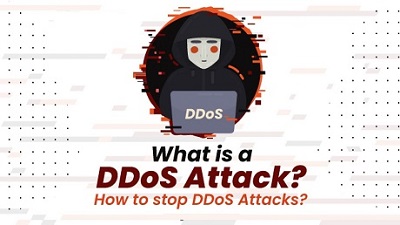A distributed denial-of-service attack (DDoS attack) sees an attacker flooding the network or servers of the victim with a wave of internet traffic so big that their infrastructure is overwhelmed by the number of requests for access, slowing down services or taking them fully offline and preventing legitimate users from accessing the service at all. While a DDoS attack is one of the least sophisticated categories of cyberattack, it also has the potential to be one of the most disruptive and most powerful by taking websites and digital services offline for significant periods of time that can range from seconds to even weeks at a time. DDoS attacks are carried out using a network of internet-connected machines – PCs, laptops, servers, Internet of Things devices – all controlled by the attacker. These could be anywhere (hence the term 'distributed') and it's unlikely the owners of the devices realize what they are being used for as they are likely to have been hijacked by hackers. Common ways in which cybercriminals take control of machines include malware attacks and gaining access by using the default user name and password the product is issued with – if the device has a password at all. Once the attackers have breached the device, it becomes part of a botnet – a group of machines under their control. Botnets can be used for all manner of malicious activities, including distributing phishing emails, malware or ransomware, or in the case of a DDoS attack, as the source of a flood of internet traffic. The size of a botnet can range from a relatively small number of zombie devices to millions of them. Either way, the botnet's controllers can turn the web traffic generated towards a target and conduct a DDoS attack. Servers, networks, and online services are designed to cope with a certain amount of internet traffic but, if they're flooded with additional traffic in a DDoS attack, they become overwhelmed. The high amounts of traffic being sent by the DDoS attack clog up or takes down the systems' capabilities, while also preventing legitimate users from accessing services (which is the 'denial of service' element). An IP stressor is a service that can be used by organizations to test the robustness of their networks and servers. The goal of this test is to find out if the existing bandwidth and network capacity are enough to handle additional traffic. An IT department using a stressor to test their own network is a perfectly legitimate application of an IP stressor. However, using an IP stressor against a network that you don't operate is illegal in many parts of the world – because the end result could be a DDoS attack. However, there are cyber-criminal groups and individuals that will actively use IP stressors as part of a DDoS attack. What's widely regarded as the first malicious DDoS attack occurred in July 1999 when the computer network at the University of Minnesota was taken down for two days. A network of 114 computers infected with Trin00 malware all directed their traffic at a computer at the university, overwhelming the network with traffic and blocking legitimate use. No effort was made to hide the IP address of the computers launching the traffic – and the owners of the attacking systems had no idea their computers were infected with malware and were causing an outage elsewhere. The world didn't have to wait long after the University of Minnesota incident to see how disruptive DDoS attacks could be. By February 2000, 15-year-old Canadian Michael Calce – online alias MafiaBoy – had managed to take over a number of university networks, roping a large number of computers into a botnet. He used this for a DDoS attack that took down some of the biggest websites at the start of the new millennium, including Yahoo! – which at the time was the biggest search engine in the world – eBay, Amazon, CNN, and more. By the mid-2000s, it was apparent that DDoS attacks could be a potent tool in the cybercriminal arsenal, but the world was about to see a new example of how disruptive DDoS attacks could be; by taking down the internet services of an entire country. In April 2007, Estonia was – and still is – one of the most digitally advanced countries in the world, with almost every government service accessible online to the country's 1.3 million citizens through an online ID system. But from 27 April, Estonia was hit with a series of DDoS attacks disrupting all online services in the country, as well as parliament, banks, ministries, newspapers, and broadcasters. People weren't able to access the services they needed on a daily basis. For complete details visit OUR FORUM.
